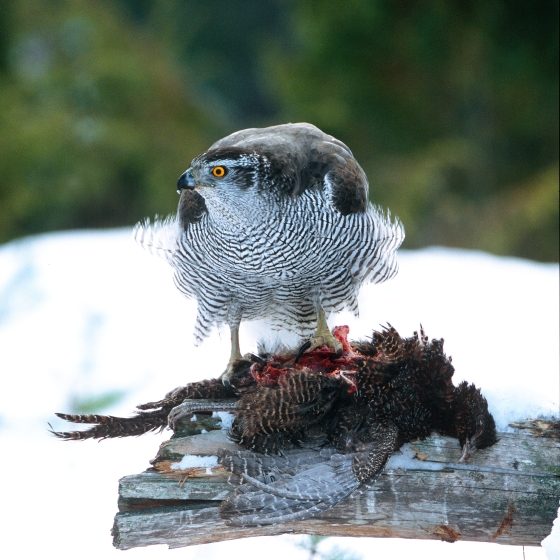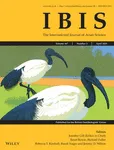Goshawk

Introduction
This large and powerful bird is easily overlooked, its presence most readily revealed during the early breeding season when individuals make display flights over their woodland territories.
The Goshawk was an extremely rare bird historically, and may even have been lost from our shores as a breeding species during the late 1800s. Increasing numbers of records from the 1960s have been linked to escaped or deliberately released captive birds, and it is from these beginnings that our current population originates.
Now a widespread bird across much of Wales and southern Scotland, other populations show a more discrete distribution, often centred on large expanses of forest or woodland – e.g. the New Forest, Thetford Forest. The species is the target of persecution, a factor that was implicated in its poor fortunes back in the 1800s.

Key Stats
Identification
Songs and Calls
Call:
Begging call:
Status and Trends
Conservation Status
Population Change
This species was driven to extinction by the late 19th century, with the decline attributed to deforestation and persecution (Hollom 1957). The subsequent population is believed to have arisen from birds which have been deliberately or accidentally released by falconers from the 1960s and 1970s onwards (Marquiss & Newton 1982) with the numbers and range initially increasing very slowly and the distribution remaining patchy (Balmer et al. 2013). Rare Breeding Birds Panel data indicate that the Goshawk population has increased strongly across the UK over recent decades,with a mean of 712 breeding pairs reported for the five-year period 2015–2019; estimates from county recorders suggest a populaton of around 1,200+ pairs (Eaton et al. 2021).
Distribution
Goshawks are resident, leading to similar patterns of distribution and abundance between seasons. Outside Wales and the Borders, the distribution comprises a number of clusters of occupied 10-km squares. Many territories are associated with large state-owned forests.
Occupied 10-km squares in UK
or view it on Bird Atlas Mapstore.
or view it on Bird Atlas Mapstore.
European Distribution Map
Distribution Change
There have been significant range expansions in both seasons. Some may be due to better coverage and reporting, but there has undoubtedly been a concurrent population increase.
Change in occupied 10-km squares in the UK
or view it on Bird Atlas Mapstore.
or view it on Bird Atlas Mapstore.
Seasonality
Goshawks are present year-round but recorded most often in late winter/early spring during spring aerial displays.
Weekly pattern of occurrence
The graph shows when the species is present in the UK, with taller bars indicating a higher likelihood of encountering the species in appropriate regions and habitats.

Movement
Britain & Ireland movement
Foreign locations of birds ringed or recovered in Britain & Ireland
Dots show the foreign destinations of birds ringed in Britain & Ireland, and the origins of birds ringed overseas that were subsequently recaptured, resighted or found dead in Britain & Ireland. Dot colours indicate the time of year that the species was present at the location.
- Winter (Nov-Feb)
- Spring (Mar-Apr)
- Summer (May-Jul)
- Autumn (Aug-Oct)

European movements
EuroBirdPortal uses birdwatcher's records, such as those logged in BirdTrack to map the flows of birds as they arrive and depart Europe. See maps for this species here.
The Eurasian-African Migration Atlas shows movements of individual birds ringed or recovered in Europe. See maps for this species here.
Biology
Productivity and Nesting
Nesting timing
Egg measurements
Clutch Size
Survival and Longevity
Survival is shown as the proportion of birds surviving from one year to the next and is derived from bird ringing data. It can also be used to estimate how long birds typically live.
View number ringed each year in the Online Ringing Report.
lifespan
Survival of adults
Survival of juveniles
Biometrics
Wing length and body weights are from live birds (source).
Ring Size
Classification, names and codes
Classification and Codes
- Order: Accipitriformes
- Family: Accipitridae
- Scientific name: Astur gentilis
- Authority: Linnaeus, 1758
- BTO 2-letter code: GI
- BTO 5-letter code: GOSHA
- Euring code number: 2670
Alternate species names
- Catalan: astor comú
- Czech: jestráb lesní
- Danish: Duehøg
- Dutch: Havik
- Estonian: kanakull
- Finnish: kanahaukka
- French: Autour des palombes
- Gaelic: Glas-sheabhag
- German: Habicht
- Hungarian: héja
- Icelandic: Gáshaukur
- Irish: Spioróg Mhór
- Italian: Astore
- Latvian: vistu vanags
- Lithuanian: paprastasis vištvanagis
- Norwegian: Hønsehauk
- Polish: jastrzab (zwyczajny)
- Portuguese: açor
- Slovak: jastrab velký
- Slovenian: kragulj
- Spanish: Azor común
- Swedish: duvhök
- Welsh: Gwalch Marth
- English folkname(s): Pigeon Hawk
Research
Causes of Change and Solutions
Causes of change
The UK population originates from birds deliberately or accidentally released by falconers during the 1960s and 1970s (Balmer et al. 2013). The localised pattern of such releases and high levels of illegal killing are believed to have influenced the patchy distribution of this species across the UK (Marquiss et al. 2003), as it is slow to disperse and colonise new breeding areas. Goshawks in the UK are often associated with large forests, often conifer plantations and this may influence their distribution in the UK, although some continental populations do breed in urban areas. Habitat quality and weather during the breeding season and in autumn were the most important drivers of population growth rate in a German population (Krüger & Lindström 2001); similar factors could be influencing the trend in the UK, but this should not be assumed as the range expansion of the UK population is ongoing and the relative importance of these factors and other factors may be different.
Publications (3)
Post-fledging movements in an elusive raptor, the Eurasian Goshawk Accipiter gentilis: scale of dispersal, foraging range and habitat interactions in lowland England
Author: Henderson, I., Barton, M., Field, A., Husbands, R., Jones, G., Armour-Chelu, N. & Conway, G.J
Published: 2025
GPS tracking of young Goshawks in lowland England reveals the movements and habitat use of this species, how these characteristics differ between the sexes, and how they change over the birds’ early lives.
14.03.25
Papers

Birds of Conservation Concern Wales 4: the population status of birds in Wales
Author: Johnstone, I.G., Hughes, J., Balmer, D.E., Brenchley, A., Facey, R.J., Lindley, P.J., Noble, D.G. & Taylor, R.C.
Published: 2022
The latest review of the conservation status of birds in Wales. The report assessed all 220 bird species which regularly occur in Wales. There are now 60 species of bird on the Red List, with 91 on the Amber List and just 69 - less than a third of the total number of species - on the Green List.
06.12.22
Reports Birds of Conservation Concern

Exploring the lives of Goshawks in the Brecks: identifying patterns in nest behaviour, habitat use and movements within and beyond the Brecks
Author: Henderson, I., Conway, G.
Published: 2017
01.07.17
Papers

